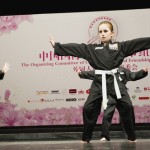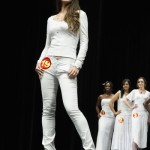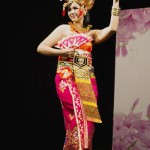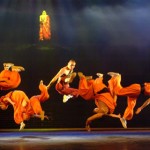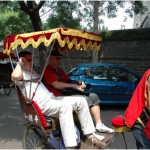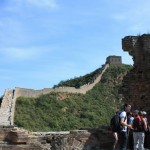Beijing (Capital City of China) As the capital of China, Beijing is one of the world’s truly imposing cities, with a 3,000-year history and 22 million. Covering 16,808 square kilometers in area, it is the political, cultural and economic center of the People’s Republic.
Situated in northeast China, Beijing adjoins the Inner Mongolian Highland to the northwest and the Great Northern Plain to the south. Five rivers run through the city, connecting it to the eastern Bohai Sea. Administratively, the Beijing municipality equals the status of a province, reporting directly to the central government. Rich in history, Beijing has been China’s primary capital for more than seven centuries. China’s imperial past and political present meet at Tiananmen square, where the Forbidden City palace of the emperors gives way to the Great Hall of the People congress building and the mausoleum of Chairman Mao Zedong. The old city walls have been replaced by ring roads, and many of the old residential districts of alleys and courtyard houses have been turned into high-rise hotels, office buildings, and department stores. Beijing, a dynamic city where the old and new intermingle, remains a magnet for visitors from inside and outside China.
Beijing is a city of broad boulevards, now full of traffic and pulsating to the rhythms of commerce and entertainment. Museums and parks abound, including the Palace Museum of the Forbidden City and Beihai Park in the center of town. Nearby, the China Fine Arts Museum (Zhongguo meishuguan) exhibits the work of contemporary artists. China’s ancient past and recent history are on view at the Museum of Chinese History and Chinese Revolution at Tiananmen. Antiques, crafts, and books can be found at Liulichang, an old antique market district remodeled in the 1980’s to reflect the style of the old city. Some of the spirit of Old Beijing is also preserved at Qianmen, south of Tiananmen, with stores that date to the early 20th century and beyond, including the Tongrentang Traditional Medicine Shop, first established in 1669. Beijing Opera performances and acrobatic troupes keep those traditional entertainment forms vital, while contemporary music clubs and discos thrive in an era of liberalization and prosperity.
The Forbidden City (Imperial Palace, Palace Museum, Gugong) At the city center is the imperial palace complex of 24 Ming and Qing dynasty emperors. In imperial times it was called as the Purple Forbidden City from the association of the emperors with the color of the Pole Star. Surrounded by 10 meter (32 feet) high walls and gates and a 50m (164 ft.) wide moat, it was inaccessible to ordinary people, but well populated by imperial family members, their servants and staffs, officials, and guards. The major ceremonial buildings of the palace are aligned on a north-south axis that extends beyond the walls toward the Temple of Heaven complex and Yongding Gate in the south. The main entrance to the palace complex is via the Meridian Gate (Wumen), from which the New Year was announced each year by the emperor, proclamations were read, and the fate of prisoners decided. Past five white marble bridges and the Gate of Supreme Harmony, a great courtyard could accommodate up to several thousand people for state ceremonies such as the imperial weddings.
The three most important ceremonial buildings are on the north-south axis, raised on a high white marble terrace, and accessed by ramps carved with ornate dragons over which the emperor was carried in a palanquin. The three main halls and associated side buildings formed the outer courtyard of the Forbidden City, devoted primarily to official and ceremonial functions, but including imperial libraries and studies. The inner chambers at the rear of the Forbidden City included private living and sleeping quarters of the imperial family, divided into three palaces and twelve courtyards. The Western Palaces were the residences of empresses, concubines, and princes. The Eastern Palace halls are now used as museum exhibition spaces, devoted to ritual bronze vessels, ceramics, craft objects, antique clocks, and paintings, including objects from the imperial collections and archaeological finds. The back precincts include the Palace of Aging Peacefully (Ningshou Gong) where the Qianlong Emperor of the late 18th century spent his retirement years.
Tiananmen Square Just south of the Forbidden City is Tiananmen Square (The Gate of Heavenly Peace Square), the largest inner-city square in the world that can hold up to a million people. It was cleared in 1958 to commemorate the tenth anniversary of the founding of the People’s Republic, replacing an older open space in front of the Gate of Heavenly Peace, the main entrance to the imperial city, that had a longer history of political importance. On May 4, 1919, students demonstrated here against provisions of the Treaty of Versailles following World War I that were considered unfair to China. The May Fourth Movement spawned here was a widespread movement for political and literary modernization that impacted the rest of the century.
After the founding of the People’s Republic, Tiananmen Square became symbolic of the socialist state through the construction in 1959 of the Great Hall of the People on its western side, and the Museums of Chinese History and the Chinese Revolution on its eastern edge. In the same period, a Monument to the People’s Heroes was erected in the center of the square. In addition, following Chairman Mao Zedong’s death in 1976, a Chairman Mao Mausoleum building was erected directly on the main north-south axis of the square. It contains the preserved body of Mao in a crystal sarcophagus, along with a standing marble statue of the Chairman. China’s imperial past, revolutionary history, and political present are all represented vividly in Tiananmen Square.(More China vacations information at Travel 2 China Info Dot COM) Temple of Heaven Located in the southern part of the city, close to the main north-south axis leading to the Forbidden City, is the Temple of Heaven complex of ritual buildings. The halls and altars here are round, symbolic of heaven.?A counterpart Earth Altar in the north of the city uses the square profile symbolic of earth; temples of the sun (in the east) and moon (west) complete a ceremonial surround for Beijing that made it not only a political capital but also a ritual center, shaped in the form of a cosmic diagram. The emperor, as Son of Heaven, performed priestly as well as ruling functions. Each year on the day of the winter solstice, following three days of fasting and meditation, the emperor would offer sacrifices and pray for a good harvest at the Altar of Heaven, a three-tiered round white marble structure, built in 1530 and reconstructed in 1740. The round altar sits on a square base, symbolic of the meeting of heaven and earth, a theme carried through in the shape of the complex as a whole, a semicircle atop a square. (More China vacations information at Travel 2 China Info Dot COM) Just north of the Altar of Heaven is the octagonal Imperial Vault of Heaven building, which contained tablets of the imperial ancestors and astronomical plaques of the constellations and meteorological occurrences. The outer wall of the Vault of Heaven Hall is known as the Echo Wall, from its ability to transmit even whispered voices around its length. Farther north is the Hall of Prayer for Good Harvests, originally built in 1420, remodeled in 1545, destroyed by lightning in 1889, and rebuilt in the following year, in part using Oregon fir wood for the supporting pillars. West of these buildings is the Altar of Farming, where each year in spring the emperor personally ploughed eight furrows to symbolically assure a good harvest. The Hall of the Year Gods (now housing the Museum of Chinese Architecture) was where the emperor sacrificed to the gods of the year and asked for a good harvest.(More China vacations information at Travel 2 China Info Dot COM) Summer Palace Fifteen kilometers (9 miles) to the northwest of Beijing is the Summer Palace. Now a large park of 716 acres, it was formerly the imperial garden retreat from the summer heat of Beijing. Surrounding hills shelter the site, and the Kunming Lake provides a cooling effect. The site was used as an imperial park as early as the mid-12th century, and continued as an imperial garden in the Ming and Qing dynasties. In 1860 Anglo-French forces burned the site to the ground.?It was reconstructed by the Empress Dowager Cixi in 1888, using funds that had been reserved for building a modern naval force. The large marble boat that sits immobile by the edge of the lake is an ironic reminder of the waste and mismanagement that led to the decline of the imperial state. The Great Wall The Great Wall is perhaps China’s most famous and most mythologized site. Several sections are conveniently visited from Beijing, including at Badaling, the most popular site, about 70 km (43 mi.) northwest of Beijing and at Mutianyu, 90 km (56 mi.) northeast of Beijing. These impressive brick and earth structures date from the Ming dynasty, when the wall was fortified against Mongol forces to the north. The Ming wall is about 26 feet tall and 23 feet wide at the base, and could accommodate up to six horsemen riding abreast. Watch towers were built on high points every 200-300 meters or so with small garrison forces that could communicate with fire signals or fireworks. These stretches of the wall are part of a system that extends from the Shanhaiguan fortress on the Bohai Gulf in the east to the Jiayuguan fortress in the west, altogether some 6000 km (3700 mi). (More China vacations information at Travel 2 China Info Dot COM) The Ming sections of the wall are only a late stage in a long history, much of which has little to do with the present structures.?The wall is most often associated with the First Emperor of China (Qin Shi Huangdi, reigned 221-210 BC), who after unifying China by conquest undertook to link up previously existing sections of walls belonging to conquered states, but on a course far to the north of the present wall. The First Emperor mobilized massive conscripted labor forces, including convicts and prisoners, by some accounts up to a million strong, to conduct this building campaign. While the Great Wall in its various versions had real military defensive functions, it also served symbolic purposes. For long periods Chinese populations lived north of the wall and nomads or semi-nomads lived south of it. The wall served as a symbolic reminder of dynastic authority and also of cultural distinction between settled agrarian culture and cities on the Chinese side and pastoral horsemen on the other. It continues today to serve as a marker of cultural and national identity. Where Can I Find 24-hour Stores in Beijing? Many people feel summer evenings are much more agreeable than daytime. It’s cooler and the neon lights create a glittering skyline. So to enjoy the evening, some prefer to have fun and stay up until late at night. In case that they may need some snacks, drinks or things urgently to have fun, Beijing has many convenience stores operating around the clock to serve their needs at any hour.(More China vacations information at Travel 2 China Info Dot COM) Seven-Eleven Seven-Eleven has lots of food on hand, like instant noodles, biscuits, potato chips, chewing gum, as well as magazines, newspapers, hair care products, batteries, cigars, beer and even Chinese Maotai wine, which is a must for a formal Chinese banquet. Seven-Eleven features fresh -made food as well as fresh local food, such as deep-fried dough sticks, soybean milk, hot rice porridge, and various breads. Location: No.5 Dongzhimei Neidajie, Dongcheng District Tel: 010-84060189 Beijing Green Tree Market Green Tree Market features Korean goods ranging from food to things for daily use. Here ice cream lovers can find original Korean ice cream which are reasonably priced, about 10 yuan each.
Green Tree Market also has a counter dedicated to Korean skin care product line The Face Shop, which aren’t too expensive. Shoppers who are hungry late at night can also find fresh sushi here, which are made by chefs on the spot. Location: No.18 Wangzhuanglu, Wudaokou, Haidian District Tel: 010-62318113 Hi-24 This is the favorite spot of middle school students who come here for lunch. Hi-24 stores are usually not big and things here are priced a bit higher than most other convenient stores. Yet here shoppers can always find the latest snacks and drinks. Besides, at Hi-24 stores shopper can also recharge their IC bus transportation card here. Location: No.178 Di’anmen Waidajie, Xicheng District Tel: 010-64045257 Xu Yong’s Photo Tour of Beijing’s “hutongs”.
Hutong Exploration Cycle around the interesting old hutong, listen to the guide elaborate the beauty of Beijing’s history, hutong life, customs, and architecture. Visit a 100-year-old whorehouse before moving on for a 15-minute sojourn around an antique market nearby. The last stop is at Houhai for a tea or beer break before cycling back to the hotel. Price: 100 yuan (US$12) including bicycle rental and English speaking guide. 70 yuan (US$8.4) for those with their own bike. Time/date: 1 to 4:30 PM, October 23 Meeting place: the entrance of Beijing International Hotel, 9 Jianguomennei Dajie, Dongcheng District, Cycle China staff will carry a flag with Cycle China logo. Reservations are required at [email protected]. Poems and Music Come to appreciate Chinese classical music and hear about the stories of the related poems. Understand how Chinese people connect the two to create a specific image to express their feelings and cultivate their minds. Price: 50 yuan (US$6) Time/date: 7:30 to 9 PM, October 27 Place: Inside the Kent Centre, northeast of Lufthansa Center, Anjialou and Liangma Lu, Chaoyang District Tel: 86-10-6432-9341
Xinjiang Dance Learn about Xinjiang dance, one of China’s most typical folk dances, with professional dancers and national first-class dance teachers. Price: 60 yuan (US$7.2) Time/date: 7 to 8:30 PM, October 24, 31 Place: Peking Opera Photography House, inside Kent Center northeast of Luftansa Centre, Anjialou, Chaoyang District Reservation at 86-10-6432-9341
SOURCE: chinatour.com

